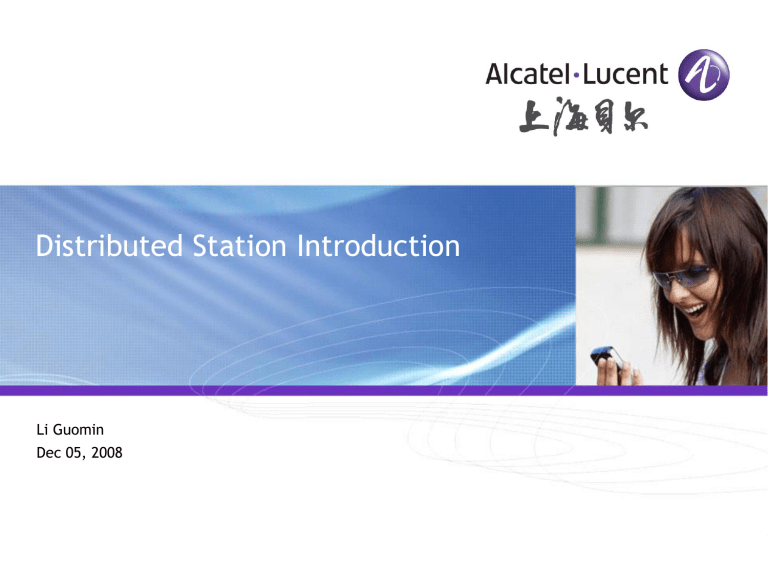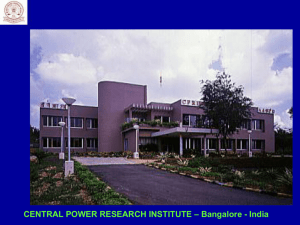
Distributed Station Introduction
Li Guomin
Dec 05, 2008
Purpose
1) Compare the traditional station with distributed station, to
learn the benefits and values of distributed station
2) Introduce Alcatel-Lucent distributed station solution
3) Introduce an internal interface of radio base station between
Radio Equipment Control (REC) and Radio Equipment (RE)
All Rights Reserved © Alcatel Shanghai Bell 2007, #####
Agenda
1. Traditional Station vs Distributed Station
2. Alcatel-Lucent Distributed Station Solution
3. CPRI (Common Public Radio Interface)
All Rights Reserved © Alcatel Shanghai Bell 2007, #####
1
Traditional Station vs Distributed Station
All Rights Reserved © Alcatel Shanghai Bell 2007, #####
Traditional Station - iBTS Indoor 600m
Advantage:
• High capacity
Disadvantage:
• Inconvenient to deploy;
• Difficulty to expand;
• High power consumption
All Rights Reserved © Alcatel Shanghai Bell 2007, #####
Distributed Station - d2U + RRH/TRDU
DDM
PA
TRM
RRH
TRDU
CCM + CEM
d2U
All Rights Reserved © Alcatel Shanghai Bell 2007, #####
2
Alcatel-Lucent Distributed Station Solution
All Rights Reserved © Alcatel Shanghai Bell 2007, #####
Solution Overview
• Macro BTS (with CxOIM) + HSSL RRH
• dCompact BTS (with iCEM-2/xCEM + iCCM-2/xCCM + GPxOIM) + HSSL RRH
• Macro BTS (with xCCM + xCOB) + CPRI RRH/TRDU
• GSM Site + d2U + RRH/TRDU
• d2U/d4U + RRH/TRDU
• dCompact BTS/d2U/d4U + rCompact BTS OD
All Rights Reserved © Alcatel Shanghai Bell 2007, #####
Macro BTS (with CxOIM) + HSSL RRH
With CxOIM card, traditional station can be
expanded easily, not need deploy new
station, save cost for customer.
Optical
All Rights Reserved © Alcatel Shanghai Bell 2007, #####
dCompact BTS (with iCEM-2/xCEM + iCCM-2/xCCM + GPxOIM) + HSSL RRH
All Rights Reserved © Alcatel Shanghai Bell 2007, #####
Macro BTS (with xCCM + xCOB) + CPRI RRH/TRDU
With single xCOB card, up
to six CPRI RRHs can be
connected, along with
the daisy-chain
implemented in UA07,
more RRHs can be
connected.
All Rights Reserved © Alcatel Shanghai Bell 2007, #####
GSM Site + d2U + RRH/TRDU
VALUE
Investment protection
Capitalize on existing assets
RF (2G + 3G)
No need for new site acquisition
(issue in some markets e.g. UK)
Same KPIs and features as Macro Node B
Easy 3G introduction at minimum cost:
“zero footprint” by module plug-in
GSM Modules
Additional flexibility with SDR TRx
d-NodeB 2U/4U can also be connected to
RRHs or r-NodeB Compact
d-NodeB 2U
Reuse GSM sites, cabinets
Reuse feeders/antennas (900MHz)
All Rights Reserved © Alcatel Shanghai Bell 2007, #####
d2U/d4U + RRH/TRDU
All Rights Reserved © Alcatel Shanghai Bell 2007, #####
dCompact BTS/d2U/d4U + rCompact BTS OD
dCompact BTS/
d2U/d4U
The 9332 rCompact OD,
combined with the 9322
dCompact or the 9326 d2U,
offers Macro NodeB
capabilities in a compact
NodeB packaging. It
constitutes an alternative
Macro NodeB solution.
rCompact BTS Architecture
All Rights Reserved © Alcatel Shanghai Bell 2007, #####
d2U/d4U Roadmap
d4U
(??)
2UV2 Phase#2
(xCCM-U + xCEM-U)
2UV2 Phase#1
(iCCM-U + xCEM-U)
2UV1
(iCCM-U + iCEM-U)
All Rights Reserved © Alcatel Shanghai Bell 2007, #####
Distributed Station Configuration – 1 (daisy-chain)
All Rights Reserved © Alcatel Shanghai Bell 2007, #####
Distributed Station Configuration – 2 (3 RRH/TRDU)
All Rights Reserved © Alcatel Shanghai Bell 2007, #####
Distributed Station Configuration – 3 (6 RRH/TRDU)
All Rights Reserved © Alcatel Shanghai Bell 2007, #####
Distributed Station Configuration – 4 (mixed)
All Rights Reserved © Alcatel Shanghai Bell 2007, #####
Distributed Station Configuration – 5 (dual-band)
All Rights Reserved © Alcatel Shanghai Bell 2007, #####
3
CPRI (Common Public Radio Interface)
All Rights Reserved © Alcatel Shanghai Bell 2007, #####
CPRI - Overview
The Common Public Radio Interface (CPRI) is an industry cooperation aimed at
defining a publicly available specification for the key internal interface of
radio base stations between the Radio Equipment Control (REC) and the Radio
Equipment (RE).
The parties cooperating to define the specification are Ericsson AB, Huawei
Technologies Co. Ltd, NEC Corporation, Nortel Networks Ltd, Alcatel Lucent and
Nokia Siemens Networks GmbH & Co. KG.
Uu
Uu
Radio Base Station System
Radio Equipment Control (REC)
Iub
Control &
Mgmt
SAPCM
Radio Equipment (RE) #2
Radio Equipment (RE) #1
Sync User Plane
upper layers (not part of CPRI specification)
SAPS
SAPIQ
SAPCM
Layer 2
Layer 1
CPRI
SAPS
SAPIQ
SAPCM
SAPS
Layer 2
Layer 2
Layer 1
Layer 1
upper layers
SAPCM
SAPIQ
Layer 2
CPRI
Common Public Radio Interface
Common Public Radio Interface
All Rights Reserved © Alcatel Shanghai Bell 2007, #####
SAPS
Layer 1
SAPIQ
CPRI - REC/RE Function Split (1)
Functions of REC
Downlink
Functions of RE
Uplink
Downlink
Uplink
Radio base station control & management
Iub transport
RRC Channel Filtering
Iub Frame protocols
D/A conversion
A/D conversion
Down Conversion
Channel Coding
Channel De-coding
Up Conversion
Interleaving
De-Interleaving
ON/OFF
control
each carrier
Spreading
De-spreading
Carrier Multiplexing
Scrambling
De-scrambling
Power
amplification Low Noise Amplification
and limiting
Adding
channels
of
physical
Transmit Power Control
of each physical channel
of
Automatic Gain Control
Carrier De-multiplexing
Signal
distribution
to Antenna supervision
signal processing units
Transmit Power Control RF filtering
& Feedback Information
detection
RF filtering
Frame and slot signal
generation
(including
clock stabilization)
Downlink
Measurements
Measurements
Functions of REC
Functions of RE
Uplink
Downlink
Uplink
CPRI control management
CPRI topology management
CPRI interconnection between REs
(forwarding/switching/cross-connecting of CPRI SAP
data between REs)
All Rights Reserved © Alcatel Shanghai Bell 2007, #####
CPRI - REC/RE Function Split (2)
Physical Channel Spreading
REC
Physical Channel Combining
RE
Modulation
All Rights Reserved © Alcatel Shanghai Bell 2007, #####
CPRI - Protocol Overview
The user plane information is sent in
the form of IQ data. The IQ data of
different antenna carriers are
multiplexed by a time division
multiplexing scheme onto an electrical
or optical transmission line. The
control and management data are
either sent as inband protocol (for
time critical signalling data) or by
layer 3 protocols (not defined by CPRI)
that reside on top of appropriate layer
2 protocols. Two different layer 2
protocols for C&M data – subset of
High level Data Link Control (HDLC)
and Ethernet – are supported by CPRI.
These additional control and
management data are time
multiplexed with the IQ data.
All Rights Reserved © Alcatel Shanghai Bell 2007, #####
CPRI - Line Bit Rate
For flexibility and cost efficiency, 3 line bit rates are defined.
option 1: 614.4 Mbit/s
option 2: 1228.8 Mbit/s (2 x 614.4 Mbit/s)
option 3: 2457.6 Mbit/s (4 x 614.4 Mbit/s)
option 4: 3072. Mbit/s (5 x 614.4 Mbit/s)
line bit rates to be chosen for easing the recovering the basic UMTS chip
rate of 3.84 MHz
For example, 1228.8 =(3.84*32)*10
REC and RE must support at least one of the above cited line bit rates.
Notes: Alcatel-Lucent REC selected option 2, in the future, option 3 will be
supported.
All Rights Reserved © Alcatel Shanghai Bell 2007, #####
CPRI - Frame Structure
The length of a basic frame is 1 TC = 1/fc = 1/3.84 MHz = 260.416667ns. A
basic frame consists of 16 words with index W=0…15. The word with the
index W=0, 1/16 of the basic frame, is used for one control word.
The length T of the word depends on the CPRI line bit rate as shown in the
table below. Each bit within a word is addressed with the index B, where
B=0 is the LSB and B=T-1 is the MSB. Each BYTE within a word is addressed
with the index Y, where B=0 is LSB of Y=0, B=7 is MSB of Y=0, B=8 is LSB of
Y=1, etc...
All Rights Reserved © Alcatel Shanghai Bell 2007, #####
CPRI - Basic frame structure for 1228.8 Mbit/s CPRI line bit rate
All Rights Reserved © Alcatel Shanghai Bell 2007, #####
CPRI - Antenna Carrier Container (AxC container)
The Antenna Carrier (AxC) is the IQ stream for one carrier related to one antenna. The
samples for one AxC during one chip period are collected and transferred as a block,
denoted AxC container.
Example: RX diversity 2 AxC, and 2 times oversampling 2 IQ samples per AxC container.
1 Tc
I0 I1 I2 ...
Q0 Q1 Q2 ...
AxC 1
Receiver A
(f1, A branch)
AxC 2
Receiver B
(f1, B branch)
1 Tc
I0 I1 I2 ...
Q0 Q1 Q2 ...
IQ0 IQ1 IQ0 IQ1
AxC container
IQ2 IQ3 IQ2 IQ3
CPRI basic frame
All Rights Reserved © Alcatel Shanghai Bell 2007, #####
CPRI - Mapping of AxC Container within one Basic Frame
The following mapping rules apply for both, uplink and downlink:
1) Each AxC Container is sent as a block.
2) Overlap of AxC Containers is not allowed.
3) The position of each AxC Container in the IQ data block is decided by one of the
following options:
Option 1 (packed position): Each AxC Container in a basic frame is sent consecutively
(without any reserved bits in between) and in ascending order of AxC number. => selected
by Alcatel-Lucent
Option 2 (flexible position): For each AxC Container, the application shall decide at
what address (W, B – for W>0) in the IQ data block the first bit of the AxC Container is
positioned. The first bit of an AxC Container shall be positioned on an even bit position in
the IQ data block (B shall be even).
4) The bits not used by AxC Containers in the IQ data block in the basic frame shall be
treated as reserved bits (“r”).
All Rights Reserved © Alcatel Shanghai Bell 2007, #####
CPRI - Capacity in terms of Antenna-Carriers (1/2)
The capacity of one logical connection shall be expressed in terms of UTRA-FDD-antennacarriers (abbreviation: “antenna-carrier” or “AxC”). One UTRA-FDD-antenna-carrier is the
amount of digital baseband (IQ) U-plane data necessary for either reception or
transmission of one UTRA-FDD carrier at one independent antenna element. One antenna
element is typically characterized by having exactly one antenna connector to the RE.
Example:
AxC ID
0
1
2
3
4
5
6
7
8
9
10
11
Antenna
0
0
1
1
0
0
1
1
0
0
1
1
Carrier
0
1
0
1
0
1
0
1
0
1
0
1
RE ID
1
1
1
1
2
2
2
2
3
3
3
3
Usage
Y
Y
Y
Y
Y
Y
Y
Y
Y
Y
Y
Y
All Rights Reserved © Alcatel Shanghai Bell 2007, #####
CPRI - Capacity in terms of Antenna-Carriers (2/2)
CPRI shall be defined in such a way that the following typical NodeB configurations can be
supported:
• 1 RE supports one sector
Up to 4 carriers x 1 antenna per RE (e.g. 6 REs for 3 sectors).
Up to 4 carriers x 2 antennas per RE (e.g. 3 REs for 3 sectors)
• 1 RE supports 3 sectors
From 1 to 4 carriers x 2 antennas x 3 sectors per RE
REQ#
Requirement Definition
Requirement Value
Scope
R-5
Number of antenna carriers per logical connection for UTRA FDD only
4
Logical connection
R-6
Number of antenna carriers per logical connection for UTRA FDD only
6
Logical connection
R-7
Number of antenna carriers per logical connection for UTRA FDD only
8
Logical connection
R-8
Number of antenna carriers per logical connection for UTRA FDD only
12
Logical connection
R-9
Number of antenna carriers per logical connection for UTRA FDD only
18
Logical connection
R-10
Number of antenna carriers per logical connection for UTRA FDD only
24
Logical connection
Alcatel-Lucent REC supported R-8 currently, in the future, R-10 will be supported.
All Rights Reserved © Alcatel Shanghai Bell 2007, #####
CPRI - U-plane IQ Sample Width and Oversampling Ratio
Req#
Requirement Definition
Requirement Value
Scope
R-11
Minimum uplink IQ sample width for UTRA FDD only
4
Logical connection
R-12
Maximum uplink IQ sample width for UTRA FDD only
10
Logical connection
R-13
Minimum downlink IQ sample width
8
Logical connection
R-14
Maximum downlink IQ sample width
20
Logical connection
Option#1
Option#2
UL Oversampling Ratio n
2
4
UL Symbols for IQ samples
I, Q, I’, Q’
I, Q, I’, Q’, I’’, Q’’, I’’’, Q’’’
Option#1
Option#2
DL Oversampling Ratio n
1
2
DL Symbols for IQ samples
I, Q
I, Q, I’, Q’
Alcatel-Lucent Implementation:
IQ samples width: Downlink: 10 bits; Uplink: 5 bits
Oversampling ratio: Downlink 1; Uplink: 2
All Rights Reserved © Alcatel Shanghai Bell 2007, #####
CPRI - Container mapping in the IQ data block
DL example for 3 REs and 2 carriers
UL example for 3 REs and 2 carriers
All Rights Reserved © Alcatel Shanghai Bell 2007, #####
CPRI - Comparison with HSSL (1/2)
HSSL
Information flows
CPRI
IQ samples + Signaling + Timing and
Frequency Ref.
Clock scheme
Master on REC, RE phase locked on clock
retrieved from interface
Physical layer
Gigabit Ethernet
Gross Bit Rate
~1.28Gbit/s
Bandwidth for IQ samples
Antenna x Carrier mapping
Content of Data flow for Signaling
Protocol for Messaging
1.2288Gbit/s
921.6Mbit/s
Fixed
Configurable
Messaging
Inband + Messaging
ATM
HDLC + 10B Ethernet +
user defined
All Rights Reserved © Alcatel Shanghai Bell 2007, #####
CPRI - Comparison with HSSL (2/2)
Interface
IQ Format
UL
DL
(@ 2Fc)
(@ Fc)
Max. number of
Antenna x
Carrier
Configuration (with Tx
diversity)
HSSL
5 bits
10 bits
12
3 sectors x 2 Freq.
CPRI
8 bits
16 bits
6
3 sector x 1 Freq.
1 sector x 3 Freq.
7 bits
15 bits
8
1 sector x 4 Freq.
5 bits
10 bits
12
3 sectors x 2 Freq.
Introduced in CPRI specification
by Nortel request
All Rights Reserved © Alcatel Shanghai Bell 2007, #####
Reference Documents
1. UMT/BTS/DD/021952 CPRI Radio Module Management
2. WWW.CPRI.INFO CPRI Specification V4.0
3. WWW.3GPP.ORG 3GPP TS 25.213 V6.5.0 Spreading and modulation (FDD)
4. UMT/BTS/DD/020596 RRH IN DAISY CHAIN FUNCTIONAL SPECIFICATION
5. UMT/BTS/DD/020595 RRH IN REPEATER MODE FUNCTIONAL SPECIFICATION
6. UMT/BTS/DD/022465 UMTS dNodeB 2U V2/4U General Specification
7. NN-20500-003 Alcatel-Lucent 9311 Macro NodeB Indoor Technical Description
8. NN-20500-004 Alcatel-Lucent 9311 Macro NodeB Outdoor Technical Description
9. NN-20500-097 Alcatel-Lucent 9332 radio Compact NodeB Outdoor Technical Description
10. NN-20500-103 Alcatel-Lucent 9322 digital Compact NodeB Technical Description
11. NN-20500-106 Alcatel-Lucent 9341 Remote Radio Head 20W 2100 MHz Technical
Description
12. NN-20500-120 Alcatel-Lucent 9341 Remote Radio Head 40W Technical Description
All Rights Reserved © Alcatel Shanghai Bell 2007, #####
www.alcatel-sbell.com
38 | Presentation Title | Month 2006
All Rights Reserved © Alcatel Shanghai Bell 2007, #####



